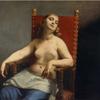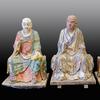Important sculpture of tragic Dolly sisters, icons of the Jazz Age for sale at Bonhams
- LONDON, United Kingdom
- /
- August 22, 2012
An ivory and bronze sculpture by Demetre Chiparus of the identical twins known as the Dolly Sisters who took the world of entertainment by storm in the 1920's will be sold on 14th November at Bonhams New Bond St. The carved ivory and bronze group made around 1925 is estimated to sell at £150,000 to £200,000.
The sisters story reads like a morality tale, fantastic fame and fortune, celebrity, gilded lovers and wild exoticism all ending in sadness, tragedy and early death.
Born in Budapest and brought to America, aged 12, in 1905 by their immigrant parents, the sisters, 'Rosie' Roszika and 'Jenny' Janszieka Schwartz were already dance-mad.
Within two years, they were on the vaudeville stage, where their looks as well as their dancing captivated audiences. They were very attractive with dark skin, shoulder-length hair and dark gipsy eyes.
Their performances at the Ziegfeld Follies on Broadway confirmed their star attraction. Men were entranced and packed their shows out. It was not long before they were receiving gifts, including on one occasion a beribboned Rolls Royce, after their show.
Soon they had stormed the heights of society and were being entertained by the Vanderbilts and Hearsts who invited them to their homes. In Europe they were to conquer even greater social heights. They came to London in 1920 to star in a Charles Cochrane stage extravaganza and met the younger sons of King George V, later meeting the Prince of Wales. His path and that of the Dollies seemed to cross for some years and it was said that he was particularly fond of Jenny. In Paris they met King Alfonso of Spain, who was a regular visitor.
One of their attractions was that the Dollies were discreet. Their romantic attachments never became public. But they broke hearts, and bank balances, too, even those of the super-rich. Gordon Selfridge, the American-born founder of Oxford Street's grand department store, at the age of 69, fell so hopelessly for the 33-year-old Jenny that he squandered a large part of his fortune on her.
Drawn to gambling they were casino regulars, winning massively, draped in the latest fashions and dripping jewelry. Their gambling earned them $850,000 in one season at Deauville and in one evening in Cannes, Jenny won four million francs which she converted into jewelry, going on to win another 11 million.
As their dancing career ended, Rosie fell in the love with a man named Irving Netcher, and was deliriously happy. Jenny was lonely and on the course that led her eventually to reach for the sash of her dressing gown committing suicide in 1941 having lost a fortune.
Rosie lived long enough to see a biopic made in 1945 of their lives called, The Dolly sisters – starring June Haver and Betty Grable, but in 1962 she attempted to follow her sister in suicide. The bid failed. She died on February 1, 1970, succumbing to heart failure.
The artist who created this memorable sculpture of the dancing duo, Demetre Chiparus, (1886-1947 , Romanian) worked in Italy before being lured to the cultural mystique of Paris in 1912 and studied at the "L'Ecole Des Beaux-Arts"
The new high-priests of fashion and chic were Coco Chanel, Sergei Diaghilev, and Jean Cocteau. This was the environment in which Chiparus established himself at the birthplace and dawn of the Art Nouveau and Art Deco movements
Equally important, the Ballet Russes opened its first season in 1909, produced by the visionary producer Sergei Diaghilev. Chiparus was greatly influenced by the ballet and depicted many of its most famous performers
The music hall was to be another important influence on Chiparus. The Dolly Sisters were well known music hall performers in the 1920s and 1930s. The girls would have worked at the Follies Bergere, the Moulin Rouge and the Alcazar, each hosting sumptuous Hollywood-style productions featuring flashy costumes and dancing which Chiparus loved to visit
Chiparus produced chryselephantine figures, often in three different sizes. The "Dolly Sisters" model being sold by Bonhams is a large sized model, standing an impressive 74cm high, and thought to be one of only five executed.
The term chryselephantine indicates sculpture that mixed carved ivory with bronze, wood, rock crystal, or lapis lazuli. Bronze was often used because it was easy to work with and it aged well. The ivory that Chiparus used was of the highest quality, imported from the Belgium Congo. It was the perfect material to depict the flesh of the chryselephantine figures.
Chiparus went on to produce over 130 different bronze and ivory figurines, but the "Dolly Sisters" would be regarded as one of his most successful studies. It captures the spirit of the Art Deco period in all its splendor and blatant beauty.
The author, Alberto Shayo, who wrote the book "Chiparus; Master of Art Deco" chose the "Dolly Sisters" study to adorn the front cover of his reference work. This large sized version that Bonhams is selling would be perceived by collectors to be among the rarest and most desirable of his studies ever to appear at auction.






_-Closing-the-Distance_100x100_c.jpg)









